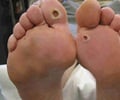Apple's studies unveil insights on exercise's positive impact on glucose and challenges for diabetics, including menstrual cycle glucose management.
World Diabetes Day: Glucose Response to Activity and the Menstrual Cycle
Go to source).
Exercise Impact on Glucose Control
As part of the study, as participants increased either the average duration of exercise or the average number of steps taken on a given day, there was a corresponding increase in the average percentage of time glucose fell within the target range of 70-180 mg/dL. People who exercised more than 30 minutes per day spent 78.8 percent of day in the target range of 70-180 mg/dL. Participants who identified as female and walked more than 10,000 steps per day saw the most time spent in the target range of 70-180 mg/dL, compared to 76.4 percent of participants who identified as male.‘Prompt identification of diabetes and meticulous management of glucose levels can diminish the risk and severity of various complications. #worlddiabetesday #diabetescare #glucose’





On menstrual cycle, analyses of glucose levels across 1,982 menstrual cycles highlighted a slight increase in time spent within the target range of 70-180 mg/dL during the follicular phase when progesterone levels are lower (68.5% of day) compared to the luteal phase (66.8% of day). Polycystic ovary syndrome (PCOS) and a body mass index greater than 30kg/m2 can also increase resistance to insulin and subsequently glucose levels, the findings showed. Shruthi Mahalingaiah, assistant professor of environmental, reproductive, and women’s health at the Harvard T.H. Chan School of Public Health, said that in a preliminary analysis, “our research team has identified an intriguing pattern in continuous glucose measurements across the menstrual cycle among people with regular cycles”.“During the follicular phase, which is characterized by higher estrogen levels and low progesterone levels, we've observed a slight increase in the time spent within the target glucose range. This discovery holds the potential to significantly improve diabetes management by providing valuable insights for optimizing blood sugar control,” Mahalingaiah added.
According to Calum MacRae, a cardiologist and professor of medicine at Harvard Medical School, and principal investigator of the Apple Heart and Movement Study at Brigham and Women’s Hospital, empowering users to move their personal physiology in the right direction is a fundamental foundation of precision health and medicine.
Apple Watch: Empowering Users to Enhance Cardiometabolic Health and Mitigate Diabetes Risk
“Apple Watch enables users to determine how best to improve their cardiometabolic risk. These data demonstrate that exercising at the right levels can improve how each of us deal with metabolic challenges to reduce the risk of diabetes or to improve the control of diabetes if it does develop,” MacRae explained.Based on these new research insights — as well as additional input from people with diabetes — Apple highlighted five features on iPhone and Apple Watch that can be useful for those with diabetes, including Activity, Cycle Tracking, Sleep, Medical ID, and third-party apps. While the Activity app allows you to set goals, record duration, and receive reminders about exercise targets, you can track your menstrual cycle, receive period predictions, as well as retrospective estimates of when you likely ovulated with Cycle Tracking.
With the Sleep app, you can set a sleep schedule, receive reminders when to wind down, and track how well you are doing in meeting your sleep goals. In the Health app, you can update your Medical ID to include information about diabetes and medications, which can be shared in various ways to help in an emergency.There are also several third party iOS apps affiliated with glucose meters, including CGMs, that help users measure and track their glucose.
Advertisement
- World Diabetes Day: Glucose Response to Activity and the Menstrual Cycle - (https://appleheartandmovementstudy.bwh.harvard.edu/trends-in-glucose-levels/)
Source-IANS














